 |
surfresearch.com.au
history
: streaks and slugs
|
streaks and slugs
1971
| home | catalogue | history | references | appendix |
 |
surfresearch.com.au
history
: streaks and slugs
|
| Mark Warren and McCoy Twin Fin 1,
Narrabeen, 1971 Photograph : Uncredited Surfing World magazine, April 1979. Volume 27 Number 6 page 34. Originally printed in Surfing World, 1971. |
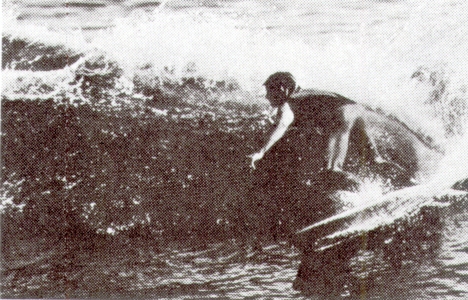 |
 |
January 1971 THESE SO CALLED POPOUTS ARE ALL HAND
SHAPED GLASSED,
AND FINISHED IN THE CUSTOM MANNER AND CARRY THE MANUFACTURERS LABEL AND GUARANTEE. Available at all leading Surf Shops throughout Australia. Free packing and delivery anywhere in Australia. No delays. WILLIAM WALLACE SURFBOARDS 8 WINBOURNE RD., BROOKVALE. PH. 93.1472 5ft 6" Twin Fin: 22.5" wide x 3.25" thick, price $75. Junior Model: 21" wide x maximum thickness 3.5", price $59. 5ft 8" x 21" wide x 3.5" thick, price $65. 6ft x 21" wide x 3.75" thick, $69. Tracks, Number 4, January 1971. |
 |
|
Manly
Surf Shop and Stor-a-Board
We're not pessimistic about our future- Bob Brewster. Tracks, Number 4, January 1971. The home of Bower Boy Surf Wax, the demand for board storage declined with rapid downsizing in surfboards since 1967. |
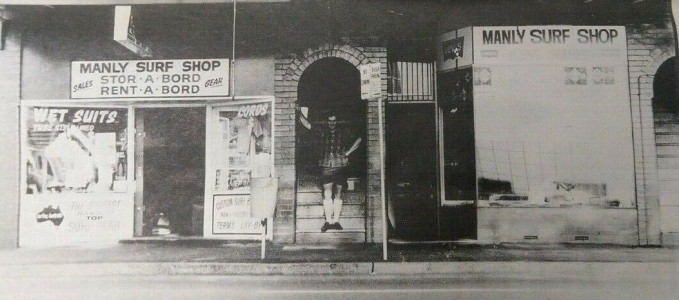 |
|
Dual fin
Dimensions5'4 ' x 20 1/2'' 'x 3 1/2" (1501b. surfer) Outline Smooth entry nose with no hip to hinder water flow, running running into a straight drag free rail rear of centre. Wide tail with rounded corners for smooth manouvering. Profile Flat plaining surface for rear 2/3 with moderate rise toward the tip. Again smooth entry, rapid release. Cross Section Soft low rails predominate with hard edges only at tail. Bottom is flat to concave through the centre and glat (sic) at the tail, with a little cushion up front. Some surfers may find a small V in the tail helpful for manouvering. Thickness is carried right through to the tail area, with just a hint of S in the deck. Fins small 6"-7". Placement is most critical. Riged (sic) Surfing Characteristics |
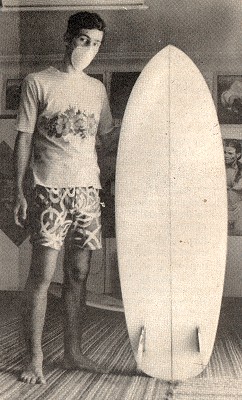 |
|
Semi-Gun
Dimensions6' 4" x 18" x 3" (1401b. surfer) Outline Generally a diamond outline with width and hip forward of centre. Acceleration straight behind hip. Narrow round tail. Pointed nose for greater penetration. Profile Soft entry nose rocker running into a 180 deg. straight. Cross Section Low rails throughout, however they are not hard. Three stage bottom - Flat under nose section, running through a concave centre to a large V in the tail. Even thickness throughout with very little S. Fin Single centre fin 6"-7" deep. Rigid with no flex, situated on tail. Surfing Characteristics Best suited to medium to large waves of delicate form. |
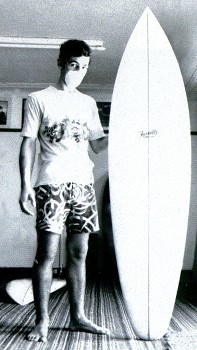 |
|
Big Wave
Design
Dimensions 7' 8" x 18" x 3 1/4'' (Built for Ted Dumuran, a 150 lb. Hawaiian) Outline Continual flowing curve form nose to tail. No straight section in the rail. Nose and tail are evenly balanced having a nose bias of only one inch. The small round tail allows tight smooth manouvering. Profile Large nose rocker running into a 180 degree flat extinding for just under two thirds of the waterline. The V in the tail has the effect of letting the rail line rise to the tail taking away the crankiness usually associated with long flats. Cross Section A very even thickness assures good balance and free running. Rails are full in shape, for good running ability yet have'a very definite edge throughout the whole length of the board which keeps all manouvering positive. Again we have a three section bottom with a large V in the tail, which has the same effect as tail rise without any of the latter's associated drag and stalling characteristics. Fin Situated on the tail. |
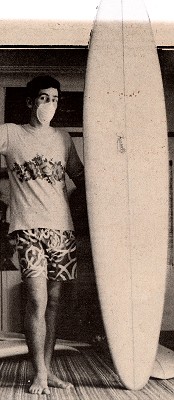 |
| This time he's back
into the angled fins. The board is 5'3" long, 21 1/2" wide and has a 12" back. Scott is not suggesting that this board is any better than the twin fins the main thing he's interested in is trying to take the thing a little further. Paul Wright rode the board at Narrabeen on a small bumpy day and said that it came around faster and bites in well and said that he definitely felt like he was surfing on his backhand. 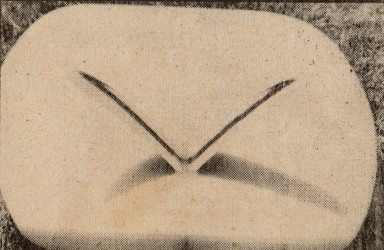 Tracks #5 Design, February 1971, page 10. |
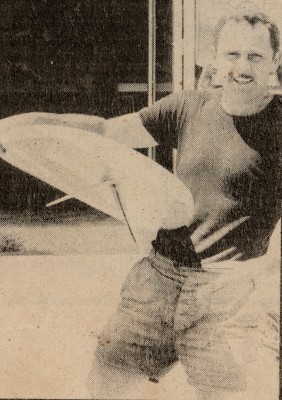 |
| 1971
Tracks #7 April Cover: Cyclones (Ida and Dora). Film: Sea of Joy by Paul Witzig. The Perfect Contest. NSW Championships Centrefold: MP footage that became part of The Morning Of The Earth. Design: Speed Boards. |
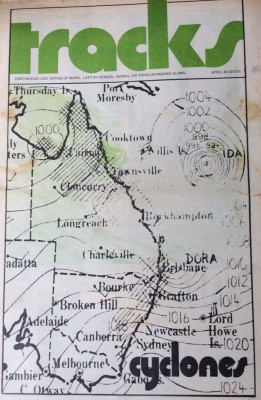 |
| 1971
Tracks # 8 May Contests: Bells (Paul Neilsen 1st, peter drouyn 2nd), Australian Titles. Water Pollution. Interview: Joe Larkin. Rusty Miller: Hawaii. Design: Bells Boards Rick Neilsen's short "three finned board ... 12'' centre fin with 4'' side fins", page 13. The side fins were at the rear of the centre fin. Also designs by: Michael Peterson, Brian Austin, Bob Cooper (2), Steve Cooney, Terry Fitzgerald (Shane), Ian Cairns, Kym Thompson, Peter Drouyn (3), others. |
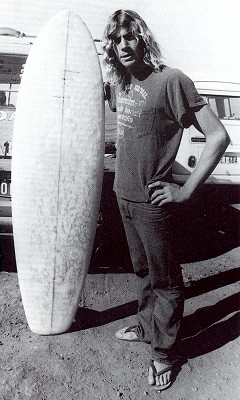 |
| 1971 In California, Con Surfboards offered two wide tailed models, the Fly and the Deuce. Fitted with three fin-boxes, the rider could choose between installing either a single or twin-fins (but not all three?). Around this time (?) Surfboards Australia, located at 5416 Gaines Street, San Diego, announced: ... the first hand-made surfboard that sells for under $100. The
all-new Smithie Model surfboard is the
result of 12 years manufacturing experience.
... made exactly like the standard custom board, it features a foam core by Pacific Foam, highest quality fiberglass and resins, Guidance System fins, and a full warranty Available in most sizes in the shapes (above) at recommended retail ... Pig shape with single giant fin ($93). The Australian twin fin ($99) Uni Twin shape with large single fin, or for use as a Twin fin, ($105). Made at the Gordon and
Smith factory (5465 Gaines Street, San Diego) Floyd Smith produced
designs under the Surfboards
Australia label following his return from Australia
at the end of the 1960s.
|
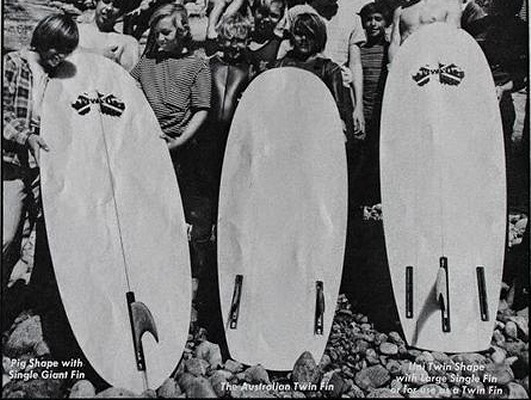 |
| 1971
Tri Fin Further multi-fin experimentation, a central standard fin with two small 2" fins set forward on the rails. the original idea possibly conceived by Reno Abelleira (Hawaii). Examples by Bob McTavish at Bennett Surfboards and Bros. Neilson. "In 1970 there were three groups
of designer/shapers who were working on the
three-fin idea," says Duncan.
-
Duncan Cambbell, quoted in John Wythe
White :Surf Wars :The Bonzar, June 16, 1999
"Bob McTavish in Australia; Dick Brewer, Reno Abellira and others in Hawai‘i; and my brother and I." http://www.honoluluweekly.com/archives/coverstory%201999/6-16-99%20Boards/6-16-99%20Boards.html Bells Contest 1971 - Design: Tracks May 1971, page 13. Rick Neilson with a short "three finned board ... 12'' centre fin with 4'' side fins." The side fins were at the rear of the centre fin. Film On Any Morning Morning of the Earth |
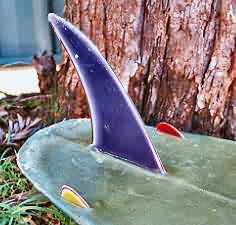 |
| Surfer Volume
12 Number 3 August 1971 Design One + Two = Free, or the Tri-Fin Trip, page 48. |
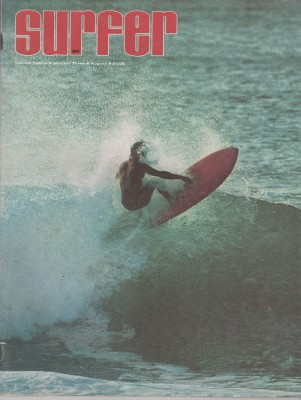 |
| Who
do you primarily think has done the
most? The one whos done the most is Dick Brewer. He's the smartest of everybody. Brewer built my brother, Gary, the first mini-gun. It was September of 1967. He's the guy that can still ride a six-two when everybody else from his generation is over the hill. I like him because he's still got kick. He's surfed every day of twelve years, and he's given his life to surfing, I can dig him! He's done more for surfing than any designer or surfer. He's taken me to the outer limits of speed and freedom and that's more than anybody done for me! He's made me the best boards I've ever ridden, and he's one of my best friends. He's taught me how to live and how to tune in. Tune into what? Into everything. I didn't used to be openminded ... I could rattle all day long about Brewer. He's a good partner of mine. I wouldn't ride anybody else's boards, not even if you gave them to me free! |
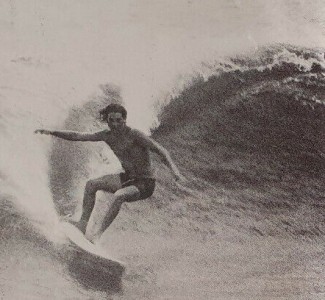 Owl
Chapman
Photo:Brewer. |
| Aqua Jet
Honeycomb* Surfboards 270 Seventh Street San Francisco, California 94103 (415) 861-8393 U.S. Patent #3,514,105 Hollow Honeycomb* construction is the newest era in the evolution of precision surfing equipment - heavy penetration... light fast and free... perfect weight distribution... alive and responsive... beautiful and beautifully functional... It's time you feel it! |
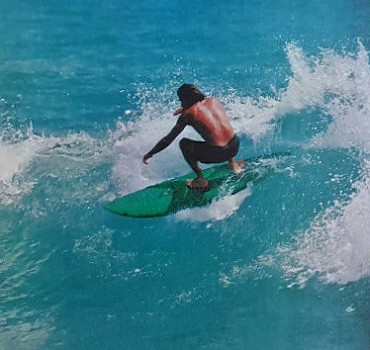 Photo sequence: Gary Chapman/Sebastian Inlet |
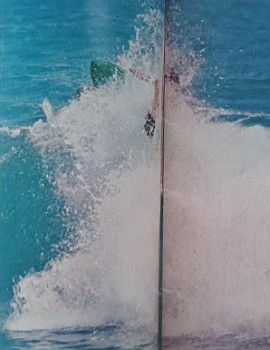 |
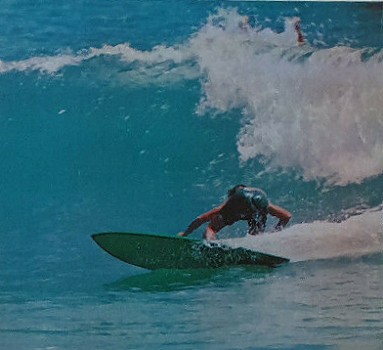 |
| 1971 Nat Pintail Heavily influenced by Hawaiian Joey Cabell's Grey Ghost, this design featured a compressed pintail gun template, 2nd phase concave bottom, soft box rails with a hard edge, large nose lift and a small Greenough single fin. Early models for Bennett Surfboards and Byron Bay models which often featured grey/blue pigment laminate. Later Sydney models had sprayed blanks. These boards were manufactured untill1980. Film: Morning of the Earth. |
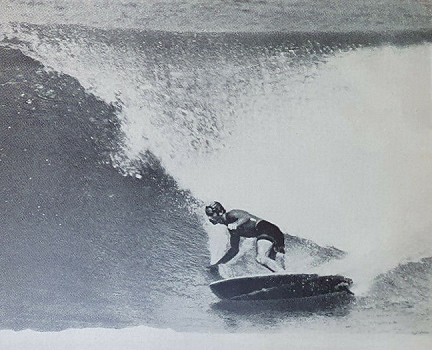 Billy
Hamilton
Surfer Volume 12 Number 3 Oct 1971 |
|
Waxmate by Surf Research,
circa 1971.
Tracks 1971, page 26. Distributors Wholesale BRISBANE: phone Hohensee Surfboards 91 1494 QLD. GOLD COAST: Hohensee Surfboards 2158 Gold Coast Highway, Miami 4220. N.S.W. NORTH COAST: Surf Research PO Box 44 Bangalow 2479. SYDNEY: Surf Research phone 919 4580 MELBOURNE: Surf Research phone 98 7325 TORQUAY: Surf Research c/o Post Office Torquay 3228 W.A.: Sommot PO Box 101 Subiaco 6008. Phone 25 6676. Send
25c for climatised purple square bar to Surf Research,
P.O. Box 44
Bangalow. N.S.W. 2479 |
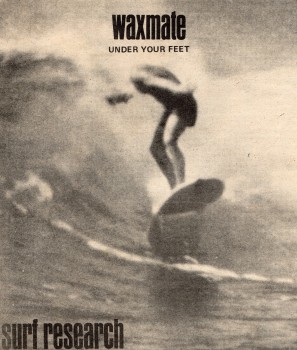 |
| home | catalogue | history | references | appendix |